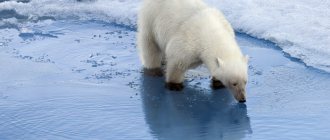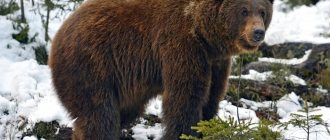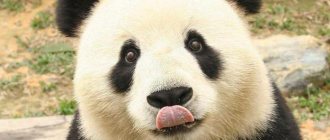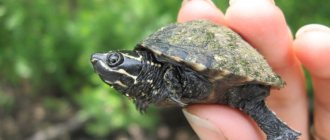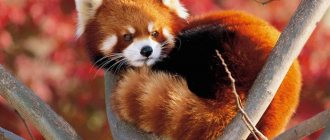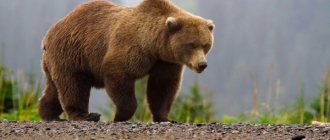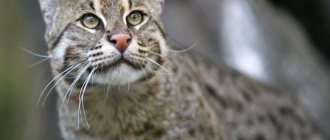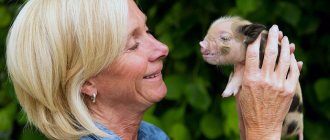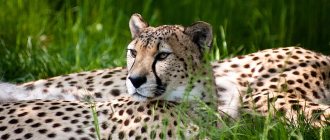All about bears
The body length of the predator, depending on the species, varies from 1.2 to 3 meters, weight can reach up to 1 ton, the jaws are very powerful, and the limbs are slightly curved and short.
The bear can reach a speed of up to 50 km/h, with the help of large and sharp claws it can easily climb a tree, tear apart its prey, and pull out plant roots from under the ground.
Most bears are good swimmers.
Life expectancy can reach 45 years. They have a good sense of smell.The bear's fur is very hard and thick, the color has various shades from brown to black, white or black and white, and gray hair may appear with age.
The tail of predators is almost invisible, only in the panda it is clearly pronounced.
Animals without fur are barely recognizable (28 photos)
Humans are not the only ones who suffer from hair loss. Whether hair loss is caused by illness or old age, the condition can affect our four-legged friends too. Hair loss from the scalp or body is technically called alopecia. This process can have many different causes, such as natural processes (seasonal factors or aging), biological disorders (imbalance of vitamins or minerals), genetic mutations, diseases or parasitic infestations. Some dogs, cats, rats and guinea pigs have even been specifically bred by humans to be hairless. Luckily, the animals and birds on our list don't seem to mind the loss of their hair, fur, or feathers. Do you think they look as cute without their fur or feathers? Rabbit
This cute bunny was born in 2009 and became an instant internet sensation because he is bald. Luckily, after three months he grew his first fur coat and turned out to be just as normal as his furry brothers and sisters. Bear Dolores the Bear is one of the bears who suffered from sudden hair loss at the Leipzig Zoo, Germany. Some experts believe it was caused by a genetic defect, although the animals do not appear to suffer from any other afflictions. Hedgehog
Meet Betty, a cute bald hedgehog from Rescue, UK. She is a healthy and completely normal animal except for the fact that she is bald and the cause of her baldness is unknown. Oscar the Parrot She pulled out her own feathers because they irritated her so much. Raccoon These mammals can sometimes develop a parasitic infestation (mange or fungal infection) that causes their hair to fall out. This is a fairly common occurrence in the wild. (Photo: broccoli) Squirrel
Photo: Murph le Hairless squirrels are not very rare; their hair loss is usually due to illness caused by ticks. Guinea pig Photo: Alina Gerika Skinny is a breed of hairless guinea pig. Judging by their pink skin, there is no need to explain why guinea pigs are called "pigs." (Photo: margaretshairlesspigs.webs.com) Penguin
This hairless baby penguin was born without feathers and was abandoned by his parents at an aquarium in China's Liaoning Province. Aquarium staff determined that the baby penguin's lack of feathers and poor health were due to difficulties digesting food and absorbing nutrients. Thanks to his keepers, the penguin was able to grow a feathered coat and was successfully reintroduced to his family. Rat Photo: CSBeck
Photo: Maxim Loskutov Hairless rats are produced by breeding different combinations of genes. Hairless lab rats, on the other hand, provide researchers with valuable data about weakened immune systems and genetic kidney diseases. (Photo: CSBeck). Chimpanzees Chimpanzees, like other apes, great apes and humans, sometimes suffer from alopecia, a disease that causes them to lose hair from all over their bodies. These poor creatures attract many visitors to zoos. (Photo: RedEyedRex) Dog
Photo: sweet mustache
These are Peruvian hairless dogs. Machu Picchu (the 4-month-old puppy in the photo above) was offered as a pet to US President Barack Obama. He promised his daughters a new pet for the White House, but the dog had to be hypoallergenic because one of them is allergic to most dog breeds. Peruvian Hairless dogs are said to be ideal for sensitive people due to their lack of hair. (Photo: Karel Navarro) Wombat Meet Karmann, an orphaned baby wombat from Australia. Wombats must remain in their mother's pouch until they reach seven months of age. However, poor Karmann was rescued from her dying mother's pouch at 3 months old, so she has no hair. She is currently being cared for at a wildlife sanctuary in Melbourne. Baboon
A hairless female baboon has been spotted in rural Zimbabwe. The animal may have lost its fur due to alopecia. However, this hairless baboon was seen in the wild, so the cause of her baldness is unknown. Kangaroo
This tiny creature is Sabrina, a female kangaroo who was abandoned by her mother in the Serengeti-Park in Germany. These animals do not grow hair until they emerge from their mother's pouch. Bald Sabrina always had to be carried close to a warm body or wrapped in a blanket to keep her warm. Hamster Hairless Syrian hamsters lack fur due to a genetic disorder. Hairless baby hamsters are only born to parents with the hairless gene, so they should not breed. (Photo: The Thicket Rabbitry)
Varieties and photos of bears
Zoologists distinguish eight main species of bears and many varieties:
Brown bear
Its external characteristics are: a large head, a rather powerful body, small ears and eyes, an almost invisible tail, large paws with large claws.
The color of six, depending on the habitat, can be brown, gray or even reddish. Brown bears are found in North America, Europe, Asia, and the Scandinavian Peninsula.
Polar bear (white)
It is the largest predator of the bear family: the weight can be more than one ton, the body length is about three meters, the head is flattened, and the neck is long. The coat color can be pure white or slightly yellowish.
The fur on the soles of the paws is very thick, which allows the bear to easily walk on ice without slipping.
Feels comfortable in the water and swims well. Lives in regions of the Northern Hemisphere.
Baribal (black)
Unlike the brown bear, it is smaller in size and its coat color is very black. It can be more than 2 meters long, the female is 1.5 m.
Elongated muzzle, long paws, short feet, gray or brown color. Lives in the territories of Alaska, Canada, Mexico.
Malayan bear
Very small, as a rule, body length no more than 1.3-1.5 m, height at the withers about 0.5 m. Stocky build, wide muzzle, small ears. The paws are high, the feet are long with large claws.
- Detailed description with photos of all animals included in the Red Book of Russia
- Zebra - habitats, appearance, diet and behavior, life cycle + 94 photos
Leopard - habitats, life cycle, rutting season and lifespan + 118 photos
The bear's fur is very hard, black-brown in color, and has a white-red spot on its chest. It can be found in Thailand, China, Indonesia.
White-breasted bear
It does not differ in large size; the male reaches a length of up to 1.7 m, and the female is even smaller. The bear's body is covered with dark brown or black silky fur; this bear also has very large ears and a sharp muzzle.
A distinctive feature of this species is a white or slightly yellowish spot on the chest. These representatives of the bear family live in Afghanistan, Iran, and the countries of the Far East, as well as in the mountains of the Himalayas.
There are still a huge number of subspecies, which can be listed and described ad infinitum. Bright representatives of predators of this species can be called such bears as: Spectacled bear (Tremarctos ornatus), Sloth bear (Melursus ursinus), Bamboo bear commonly known as panda (Ailuropoda melanoleuca), and many other.
Where does the polar bear live and how does it live?
The polar bear lives in the northern hemisphere of the Earth in the polar regions. This animal is unique and is absolutely not afraid of permafrost, because it is adapted for life in the far north with its harsh conditions. The polar bear lives in the vast Arctic. Polar bear habitat reaches 88 degrees north latitude in the north and extends to the island of Newfoundland in the south.
On the mainland, the polar bear's habitat extends through the Arctic deserts to the tundra in Russia, Canada, the United States and Greenland. The life of a polar bear is associated with the Arctic belt and is highly dependent on seasonal changes in the boundaries of polar ice.
Polar bears live along the entire coast of Greenland, inhabit the ice of the Greenland Sea south to the Jan Mayen Islands, live on the island of Spitsbergen, Franz Josef Land and Novaya Zemlya in the Barents Sea, on the islands of Bear, Vaygach and Kolguev, as well as in the Kara Sea. The largest populations of polar bears are found off the continental coasts of the Laptev and Beaufort seas, the Chukchi and East Siberian seas. The maximum population of polar bears is represented by the continental slope of the Arctic Ocean.
Polar bears live nomadic lives. During seasonal changes in the polar ice boundaries, they move. In summer, the polar bear moves closer to the pole, and in winter it moves south, entering the mainland. The polar bear lives mainly on the coast and ice, but lies in its den on the mainland or islands. Polar bears hibernate for 1.5-2.5 months, most often pregnant females do this. Males and non-pregnant females go into hibernation for only a short time, and even then not every year.
Menu for the predator
Bears eat absolutely everything as food, it can be berries and mushrooms, nuts and various roots, all kinds of meat and fish; ants, bee larvae and honey can serve as a delicacy for animals; there are also vegans among bears, these are pandas and koalas.
Among all the diversity of bears, the pure predators are again polar bears, whose diet includes only fish and meat.
Polar bear cub, or how does a polar bear cub grow?
Polar bears usually live alone. They are usually quite peaceful and calm towards each other, but the breeding season for males is always accompanied by skirmishes. The mating season for Arctic polar bears ranges from March to June. At this time, they walk in pairs, but it happens that several males can follow one female at once.
In October, females dig a den in snow drifts on the shore. Mother bears flock en masse to their favorite places to make a den and raise their babies. One of these is the Wrangel Islands and Franz Josef Land, where females make up to 200 dens annually.
Mother bears occupy a den only towards the end of autumn. The entire pregnancy period lasts 8 months. Polar bear cubs are born towards the end of the Arctic winter. Large polar bears have a low increase in offspring, because the ability to breed offspring comes only at the age of 4-8 years, and the female gives birth only once every 2-3 years. Typically, 1 to 3 polar bear cubs are born.
Polar bear cubs are born blind, with short, sparse hair and absolutely helpless. They weigh 500-800 grams with a body length of only 25 cm. The mother intensively feeds the babies with her nutritious milk. At the age of just over a month, polar bear cubs open their eyes. In March, females begin mass exits from their dens. By 2 months, the female begins to gradually take her cubs out for short walks, during which they frolic in the snow.
When polar bear cubs turn 3 months old, the female leaves the den and goes with them to wander through the icy deserts of the Arctic. The female feeds the cubs with milk for up to 1.5 years. But very soon the polar bear cubs begin an independent life. A polar bear lives 25-30 years. In captivity this period may be longer. Sometimes polar bears interbreed with brown bears. The hybrids born are called polar grizzlies.
The polar bear is listed in the Red Book of Russia and the world, with the status of a vulnerable species. The great polar bear has a high mortality rate for young animals - 10-30%. Slow reproduction makes this animal easily vulnerable, and climate change greatly affects the lives of polar bears. In addition, adult males often attack young animals.
Since 1957, Russia has introduced a ban on the hunting of polar bears. In 2014, the global number of polar bears was about 25 thousand individuals. There are about 7 thousand polar bears in Russia, and up to 150 individuals are killed by poachers every year.
The great polar bear has no natural enemies. In the water, they can occasionally be attacked by a walrus or killer whale. A polar bear cub that is left unattended by its mother can become a victim of a wolf and arctic fox. But the main threat to the polar polar bear is humans. Despite its protected status, the polar bear suffers from armed poachers.
Don’t forget to subscribe to updates on our website and join us on social networks (Vkontakte, Odnoklassniki, Instagram) so you don’t miss anything and always stay up to date with all the news!
Don't forget to share with your friends!
Keeping animals in captivity
In order for the bear to feel most comfortable, spacious enclosures are created and a habitat as close to natural as possible is created.
In addition to trees, stones and various wooden structures, such an enclosure must be equipped with a sufficiently large swimming pool.
The diet must be kept in accordance with the season and include all those elements that animals receive in their natural habitat.
Den - entrance to the underworld
Almost all peoples of the world have a special relationship with the bear. In some countries they call him the ancestor of people, and in others - a man who became a beast by the will of the gods. One way or another, Toptygin is an unusual creature, endowed with unknown magic, an assistant and friend of the gods.
The ancient legend of the Kwakiutl Indians colorfully tells how man evolved from the bear. It tells the story of a bear's love for the first man on Earth. The descendants of this couple subsequently populated the entire Earth. One of the ancient Slavic legends tells that the ancestor of people was a werebear.
The warriors of the ancient Celts also called the bear their distant ancestor. It was believed that it was he who endowed his “children” with courage, strength and ruthlessness. In ancient times, the bear was endowed with divine power. The Slavs believed that the god Veles took the form of this beast, and the bear’s den was the entrance to the underworld.
The ancient Greeks endowed Artemis, the goddess of the hunt, with bearish characteristics. A tamed bear was often housed in her temples, and during the festival in honor of the goddess, the priestesses-hunters performed a special dance, draping bear skins over their shoulders.
But most of all, historians and mystics are interested in the almost forgotten cult of the cave bear - the mysterious god of hoary antiquity. Our ancestors believed that the skull and front paws of this forest deity possessed special magical powers. Several decades ago, a strange structure was found in the Drachenloch cave (Austria) - something like a huge stone box.
The age of the find was approximately 40 thousand years. On the lid of the box lay the massive skull of a cave bear, under which rested the crossed bones of the animal's front paws. In short, the lid of the ancient chest resembled the famous emblem of the pirate “Jolly Roger”. But what surprised archaeologists most of all was the contents of this cache. The box was filled to the brim with cave bear skulls.
Scientists are still trying to answer the question of why primitive people kept these skulls and why they needed to decorate their “laying” with an eloquent sign.
It must be said that the bear cult left its mark on Russian soil. The most famous temple, dedicated to the “master of the forest,” was located on the territory of modern Yaroslavl, where people lived who worshiped a huge, mysterious bear and made generous bloody sacrifices to their deity.
According to legend, Prince Yaroslav the Wise exterminated the bloodthirsty tribe and was not afraid to engage in battle with the ferocious “god”. The prince emerged victorious from the heated duel, hacking to death the defeated Toptygin with an axe. In memory of these events, Yaroslav founded a new city (Yaroslavl) on the conquered land, the coat of arms of which was a bear with an ax standing on its hind legs.
Later, in the era of Christianity, people called the bear “brother of the devil.” It was believed that he kept order in the forest, since all evil spirits were afraid of the shaggy commander. Devils and witches run away from him, because they know that he can defeat the most merman in a duel.
It was believed that a bear could protect cattle from any harm. Therefore, Siberian peasants often hung a bear’s head in the barn, so that the “forest owner” would protect the living creatures from pestilence and misfortune.
Photo of a bear
“Forgive us, master!”
Despite the beliefs about the divine origin and magical abilities of the bear, the huge animal with thick, warm fur was considered an enviable prey. However, hunting for clubfoot has always been a somewhat sacred activity. There was a belief that the “owner of the forest” could not be killed just like any other animal.
Fearing the revenge of the brown giant, the hunters, discussing the plan for a future raid, called the intended prey by allegorical names: “old man”, “master”, “grandfather” and others. That is why the bear has so many nicknames, including Po-tapych and Toptygin, known to us from fairy tales. At the same time, it was impossible to speak disrespectfully about the bear, much less scold him, otherwise if the “old man” heard, he would definitely take revenge on the impudent one.
The northern peoples - Evenks, Kets or Nivkhs - tried to deceive the already killed “master”. During this event, the hunters lit a fire and ritually fed the bear and gave it tea. While treating the “grandfather,” they had leisurely conversations with him, convincing him that it was not they who killed the “owner of the forest,” shifting the blame to “strangers”—Russian, Yukagir or Dolgan hunters. Also, during these conversations, they asked the bear not to be angry that people would use his meat and skin, and promised to show the Toptygins every respect in the future.
And at the end of this “meal”, when the deceived spirit of the bear rushed off in search of the foreign hunters who killed him, the hunters butchered his carcass, first of all cutting off his front paw and head. They were supposed to be freed from meat, boiled and hung on a tree as a kind of amulet.
Often, when skinning a bear carcass, a stranger was present - a man from another tribe. It was believed that the presence of a stranger also helps to throw off the angry spirit of a killed bear. It was the stranger who cut out the heart of the prey and took an active part in preparing the ritual treat.
When the hunters returned to their village with their prey, all the women of the village came out to meet them. They welcomed the “shaggy old man” as a dear guest and organized a real holiday in his honor.
Russian hunters also organized a celebration in honor of a successful hunt. Usually the miners gathered in the house of the person who discovered the bear’s den, or under the roof of a brave man who was not afraid to go out with a spear against the “owner of the forest.”
Reproduction
Males and females live separately. But when the mating season begins, the male comes to the partner’s territory for the purpose of producing offspring. Most species breed from May to June. Several bears can lay claim to one she-bear, and then fights begin, after which the weak one moves away.
Cubs appear every two to four years, their number varies from one to four. Moreover, a male can come to the same female for several years.
Pregnancy lasts from 180 to 220 days; birth always occurs in winter, since the embryo does not begin to mature until November. With the onset of cold weather, the female, which has become overfed and gained weight, goes into hibernation. And when the moment comes, cubs appear in the den. Their weight is approximately half a kilo and their size is 20 cm.
In the first weeks, the cubs are almost completely bald and have no teeth. Their eyes are closed. During this period, they actively feed on their mother’s milk, gain weight and develop. Until the onset of warmth, they sit in the den and wait for the moment when the mother is ready to go outside, having finally awakened from hibernation. By the age of three months they weigh 15 kg and have a full set of baby teeth.
For the first couple of years, the offspring lives with the female. They learn to survive, hunt and continue to develop. When the time comes, mature individuals go in search of new territories that will become their home.
Kodiak
Kodiak is the largest brown bear
Among brown bears, Kodiaks are the largest . They live on the islands of the Kodiak archipelago, where people are not found very often, which eliminates serious problems with attacks by predators. Like baribals, these creatures prefer to live secretly, and they run away from people, not at all trying to make contact, or, in general, to reveal their presence in any way.
But a mother bear with cubs or an aggressive male can be very dangerous. It is worth keeping in mind that the weight of representatives of this species reaches a ton, and their height reaches almost 2.8 meters. At the moment, this is a protected species, and the natural isolation on the islands turns out to be ideal both for the bears themselves, protected from poaching, and for people.
Origin of the species
Bears appeared approximately 5 million years ago. Their ancestors were martens. It is believed that the first individuals lived in what is now France, where their remains were discovered. A thorough study helped establish that the ancient DNA species is almost completely identical to the Malay one. Gradually, bears began to expand their territories, populating Europe and Asia.
Interesting fact : the first types of bears were not large. Being the ancestors of martens, they still resembled this animal in appearance.
Due to the development of new lands and changes in environmental conditions, bears began to evolve and divide into different species. About 2 million years ago, black and brown ones appeared, which were significantly larger than their relatives in size.

